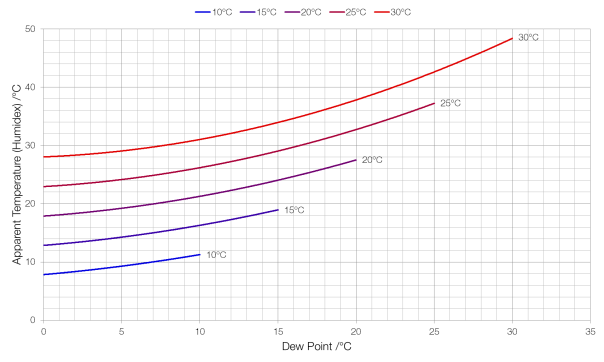Human beings judge how warm they are by how quickly heat leaves the body (we have specialised cells called thermoreceptors that do this job), and maintain temperature by controlling sweating. As sweat evaporates from the skin, it takes heat away from the body and therefore the rate of evaporation affects the rate of heat loss.
When the air is very humid, it is more difficult for evaporation to take place, and therefore humidity affects people’s perception of the temperature: when the air is very humid it feels warmer than it really is. Humidex is an index used by Canadian meteorologists to calculate this apparent temperature.
The dew point is the temperature at which water condenses out of the air and is linked to the relative humidity. If the relative humidity is 100% then the dew point is equal to the current temperature; when the current temperature is below the dew point then water will leave the air (the dew point cannot be higher than the current temperature).
As you can see, as the dew point increases the perceived temperature increases. When the air temperature is 20ºC and the dew point is also 20ºC then the perceived temperature will be 27.6ºC.
The hottest and most humid parts of the world are the coastal areas around the Arabian Peninsula. On July 8th 2003 in Dharan, Saudi Arabia the air temperature was 42.2ºC with a dew point of 35ºC; this yields a humidex of an almost-unbearable 68.9ºC. If we combined the hottest recorded temperature of 56.7ºC in Death Valley, California with this Saudi Arabian dew point record that would yield a humidex of 83.4ºC, which would have killed people: luckily the Death Valley area is a desert valley and the dew point is usually quite low.
